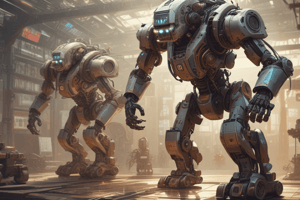Podcast
Questions and Answers
Robots can only perform complex tasks and cannot engage in simple home activities.
Robots can only perform complex tasks and cannot engage in simple home activities.
False (B)
The first known robot, Unimate, was created in the early 1960s.
The first known robot, Unimate, was created in the early 1960s.
False (B)
The wooden pigeon represents one of the earliest forms of robots.
The wooden pigeon represents one of the earliest forms of robots.
True (A)
The First Law of robotics states that a robot may injure a human being if necessary.
The First Law of robotics states that a robot may injure a human being if necessary.
Ethical dilemmas in robotics include concerns about safety and emotional responses.
Ethical dilemmas in robotics include concerns about safety and emotional responses.
Robots must protect their own existence without any conditions.
Robots must protect their own existence without any conditions.
The Quest in robotics is a completed field with no further developments anticipated.
The Quest in robotics is a completed field with no further developments anticipated.
Robots can inspire local and national movies.
Robots can inspire local and national movies.
Full autonomy in robots means they can perform activities without any external guidance.
Full autonomy in robots means they can perform activities without any external guidance.
Service robots perform tasks for humans while excluding industrial automation applications.
Service robots perform tasks for humans while excluding industrial automation applications.
The earliest conception of robots dates back to the Renaissance period.
The earliest conception of robots dates back to the Renaissance period.
A professional service robot is typically operated by a layperson for noncommercial tasks.
A professional service robot is typically operated by a layperson for noncommercial tasks.
Personal service robots are generally used for commercial tasks.
Personal service robots are generally used for commercial tasks.
Germany launched the DESIRE initiative for service robots on January 1, 2005.
Germany launched the DESIRE initiative for service robots on January 1, 2005.
Water clocks were one of the earliest examples of robots created in ancient Egypt.
Water clocks were one of the earliest examples of robots created in ancient Egypt.
Service robots can only operate with full autonomy and cannot interact with humans.
Service robots can only operate with full autonomy and cannot interact with humans.
Study Notes
Service Robots
- Robots are defined as actuated and programmable mechanisms that can move independently, performing tasks.
- Service robots are designed to assist humans or equipment with various tasks, excluding those in industrial automation.
- Personal service robots are for noncommercial tasks by individuals while professional service robots perform commercial tasks, requiring trained operators.
Robot Autonomy
- Robots display varying levels of autonomy.
- Partially autonomous robots require human-robot interaction for task completion.
- Fully autonomous robots can execute actions and activities without direct human instruction.
History of Robots
- Early robot concepts trace back to ancient Egypt (circa 3000 B.C.) with the development of water clocks, demonstrating the principles of mechanical task execution.
- The first robots were created in the early 1950s by George Devol, with the "Unimate" (Universal Automation) being a significant milestone.
Roles of Robots
- Robots play a multifaceted role in society.
- They perform intricate tasks beyond human capabilities.
- They simplify household chores, allowing humans to focus on more complex tasks.
- They are used as tools for entertainment.
- They are designed as child-friendly toys.
- They have inspired various films and media.
Robot Laws (Asimov's Laws)
- These are guidelines for robot behavior, aiming to promote ethical interaction between robots and humans.
- Law One: Robots must not harm humans or allow humans to come to harm through inaction.
- Law Two: Robots must comply with human orders unless such orders conflict with the First Law.
- Law Three: Robots must self-preserve unless it conflicts with the First or Second Law.
Ethical Dilemmas in Robotics
- One of the most significant ethical dilemmas is safety and accountability.
- Determining responsibility in case of an undesirable event involving a robot poses a significant challenge.
- The emergence of emotionally intelligent robots raises questions about human reactions and ethical considerations.
Studying That Suits You
Use AI to generate personalized quizzes and flashcards to suit your learning preferences.
Related Documents
Description
This quiz delves into the fascinating world of service robots, focusing on their design, autonomy, and historical development. It covers the distinctions between personal and professional service robots, as well as the evolution of robotic technology from ancient times to modern breakthroughs. Test your knowledge on how these robots assist in various tasks and their levels of autonomy.




